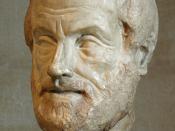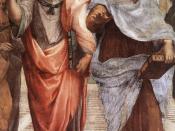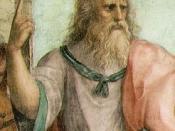Plato and Aristotle, two philosophers in the 4th century, hold polar views on politics and philosophy in general. This fact is very cleverly illustrated by Raphael's 'School of Athens' (1510-11; Stanza della Segnatura, Vatican), where Plato is portrayed looking up to the higher forms; and Aristotle is pointing down because he supports the natural sciences. In a discussion of politics, the stand point of each philosopher becomes an essential factor. It is not coincidental that Plato states in The Republic that Philosopher Rulers who possess knowledge of the good should be the governors in a city state. His strong interest in metaphysics is demonstrated in The Republic various times: for example, the similes of the cave, the sun, and the line, and his theory of the forms. Because he is so involved in metaphysics, his views on politics are more theoretical as opposed to actual. Aristotle, contrarily, holds the view that politics is the art of ruling and being ruled in turn.
In The Politics, he attempts to outline a way of governing that would be ideal for an actual state. Balance is a main word in discussing Aristotle because he believes it is the necessary element to creating a stable government. His less metaphysical approach to politics makes Aristotle more in tune with the modern world, yet he is far from modern.
Plato's concept of what politics and government should be is a direct result of his belief in the theory of forms. The theory of forms basically states that there is a higher 'form' for everything that exists in the world. Each material thing is simply a representation of the real thing which is the form. According to Plato, most people cannot see the forms, they only see their representation or their shadows, as in the...


